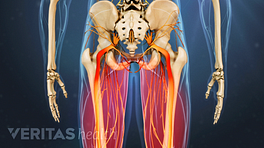While there is a wide range of non-surgical treatment options (such as pain medications, ice or heat application) that may help with some of the pain of a degenerative spondylolisthesis, there are essentially four categories of treatment options a patient will ultimately have to choose from.
Activity Modification
Patients can modify their activities so they spend more time sitting and less time standing or walking. Activity modification generally includes:
- A short period of rest (e.g. one to two days of bedrest or resting in a reclining chair)
- Avoiding standing or walking for long periods
- Avoiding active exercise
- Avoiding activities that require bending backwards.
If activity modification substantially reduces the patient’s pain and symptoms, this is an acceptable way to manage the condition long term. Simple self care can assist in this approach, such as application of cold packs and or heating pads and/or taking appropriate over-the-counter pain relievers, such as ibuprofen and/or acetaminophen, after walking or any strenuous activity.
For patients who want to be more active, stationary biking is a reasonable option, as activity in the sitting position should be tolerable. Another option is pool therapy – physical therapy done while in a warm swimming pool – as the water provides support and buoyancy and the patient is allowed to exercise in a flexed forward position.
Many patients also benefit from controlled, gradual exercise and stretching as part of a physical therapy program to maintain and/or increase range of motion and flexibility, which in turn tends to alleviate pain as well as help the patient maintain their ability to function in everyday activities.
Manual Manipulation
Chiropractic manipulation provided by chiropractors, or manual manipulation provided by osteopathic physicians, physiatrists or other appropriately trained health professionals, can help reduce pain by mobilizing painful joint dysfunction.
See Chiropractic Treatments for Lower Back Pain
Epidural Injections
For patients with severe pain, especially leg pain, epidural steroid injections may be a reasonable treatment option. The injections are effective in helping to curb pain and increase a patient’s function in up to 50% of cases. If an epidural steroid injection does work to relieve the patient’s pain, it can be done up to three times per year. The length of time that the lumbar epidural injection can be effective is variable, as the pain relief can last one week or a year.
See Epidural Steroid Injections.
Surgery
Surgery for degenerative spondylolisthesis is rarely needed, and most patients can manage their symptoms with the above non-surgical options. Surgery may be considered if the patient’s pain is disabling and they would likely be able to function better and be more active with less pain. Surgery is also indicated if the patient is experiencing progressive neurologic deterioration.
The goals of surgery are to realign the affected segment of the spine to alleviate pressure on the nerve and provide stability to the area.








